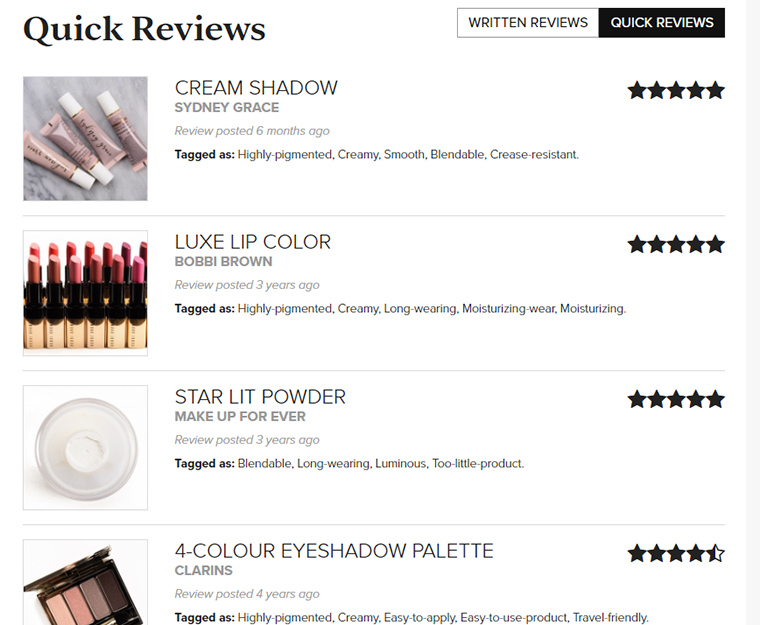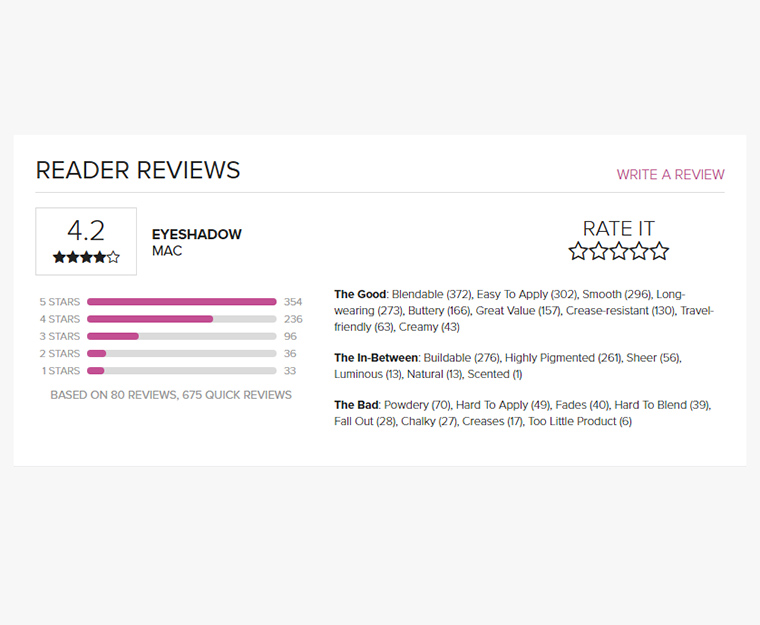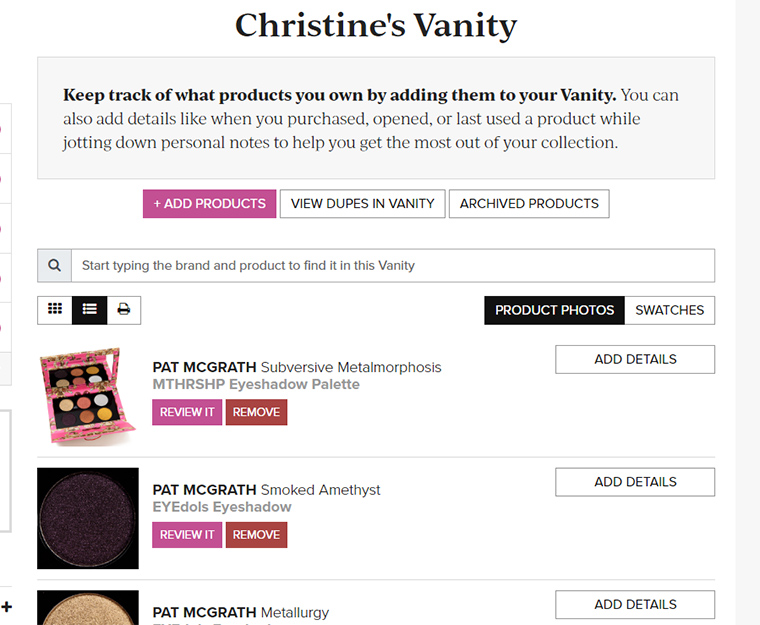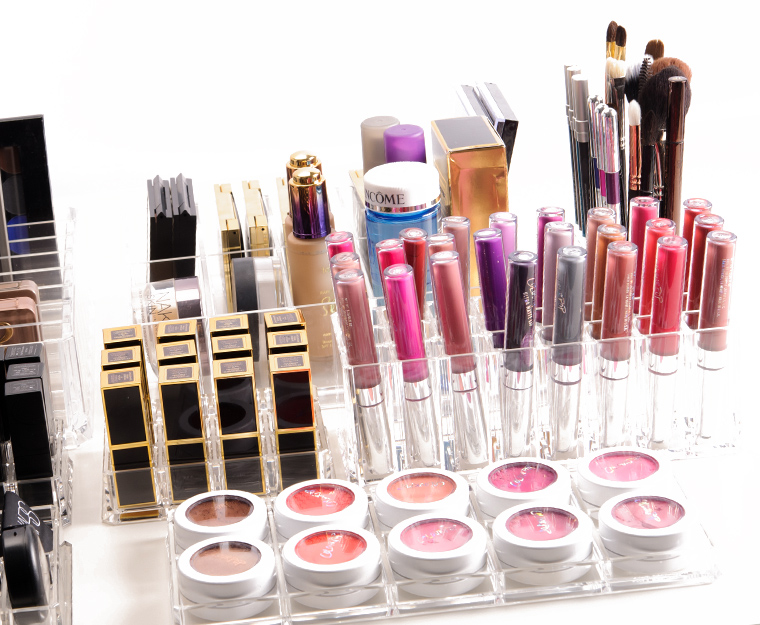
Last week, we chatted about “what makes you leave a review on a product” and “what research do you do before purchasing” and it made me think about a few things with respect to product reviews (in beauty space, of course).
The way I approach reviews is an attempt to be more objective, and it’s also in the capacity as… well, a professional reviewer, so I’ve tried to provide insight onto what makes reviews helpful and how consumers can leave better reviews but have tried to make the process as approachable as possible. My biggest tip in writing a review is asking yourself what you wished you had known about the product before purchasing (or for products like it) and answering that question!
Consumer reviews are powerful, and seeing how a breadth of people like or dislike a product (and why) is extremely helpful to other consumers looking a potential purchase. There’s a reason why brands have tried to game the system by flooding with early reviews or having employees write reviews (on the sly) — word of mouth can be a huge driver of sales!
Obviously, I very much encourage readers to leave reviews on products here on Temptalia, which was built to include reader reviews. I know we don’t edit or remove reviews because they are “negative” or mention a competitor product or whatever inane nonsense retailers use to reject reviews! A great way to start is by building your vanity (if you don’t already have one), which is a way to track products you own, and then writing reviews for the products you own!
Pro tip: If you want to leave a review on a retailer or brand website, I recommend saving a copy of your review somewhere, just in case they remove it (then perhaps, share it on more review-oriented website that is less likely to remove reviews).
Tell Us About You
In one or two sentences, giving some information about yourself and your preferences for a particular product helps set the tone and signals to others who might find your review helpful.
Here are some examples:
- I have drier skin with some noticeable flaking on my cheeks, so I’m always looking for a foundation that won’t emphasize dryness.
- I have warm undertones and a medium skin tone, so the description of “vivid orange red” was right up my alley.
- My lips are dry and flaky, so I need a hydrating formula that is forgiving when I apply it.
- I speak all day long, so I really need a lip color that lasts all day and doesn’t get on my teeth.
- My eyelids are really oily and need a primer that I can count on to prevent creasing and fading during my 10-hour work day.
- I live in a humid climate where a lot of products can’t stand up to the heat and humidity, even when I’m using primer and setting my products.
Don’t Forget to Disclose
If you have something to disclose, please make sure you do it! Transparency is critical in providing useful reviews and improving one’s credibility as a reviewer. Disclosure can range from whether you have any ties to the brand, received a product sample, have a referral code/link, etc.
Share Your Expectations
What were you hoping this product would do? What was it supposed to solve? What were you hoping it would add to your collection? Some products will have deeper explanations than others; it’s not like anyone expects an in-depth explanation of one’s 10th red lipstick purchase ?
Pro-tip: Know What You’re Purchasing
There are a few caveats to a great review, and one of them is knowing what you’re purchasing. If you’ve purchased a full-coverage foundation when you wanted a sheer foundation and then write a review that criticizes it for being full-coverage, that doesn’t end up being as helpful as it could be. It’s not that you can’t review it–you might have a preference but doesn’t mean you can’t share how it applied, felt, lasted–but if the only reason you dislike it is for one of its marketed features, it didn’t actually earn that low-rating (and can skew the product’s rating in general).
Examples:
- I’ve been looking for a buildable coverage foundation that is easy to apply and lasts for at least 10 hours.
- My lids have uneven color, and I need really opaque eyeshadow so that the color remains true.
- I’ve been looking for a one-and-done, sparkly eyeshadow for quick looks.
- I love the look of sparkly eyeshadow but can’t handle fallout due to wearing contacts, so I’m always looking for the one that stays in place!
- I can be heavy handed, so I want to be able to build up coverage or something that’s very blendable in case I overdo it!
Share Your Experience
Each person’s experience is their own; other people having better or worse experiences with a product do not negate anyone else’s. This is why I always invite readers to share their own experiences with a product, especially when it runs contrary to mine, and I’m always happy for those who have better experiences (and sad for those who have worse ones!) but believe what they say is reflective of their experience with that product.
This is all about how you used the product, how it performed, and ultimately, how satisfied you were with the performance. I like to approach this part of the review with sharing how well it performed, then diving into application and troubleshooting (as applicable).
Here are some questions you might want to try to answer or use to structure your review:
- How did it perform? Did it perform well? Was it just okay? Worth the purchase or waste of money?
- How did you apply it? How did it apply? What technique(s) did you use or what was the best for application?
- Was it easy to work with? Did you have to troubleshoot?
- Were there any deal-breakers?
- What did you like/dislike? What do you wish it did/had? Anything you would you change?
- How did it last/wear/feel?
- How long did you use it for? (often more important for categories like hair care, skin care, etc.)
- Did you try it with other products? (e.g. primer, setting powder, etc.)
Examples:
- I had no trouble applying this with my dampened sponge.
- It went on evenly and didn’t settle into fine lines.
- I had time to smudge out the edges before it set into place.
- It applied unevenly, and I could not get the product to blend out.
- I tried using my favorite brush and my fingertips, but nothing seemed to work well with this product.
- It applied beautifully in the morning but looked faded and uneven by the time I took my lunch break.
- It had such a heavy scent that gave me a headache that I wouldn’t use this again, even though it was really nice in other ways.
- I loved the way the color applied evenly, but the formula was too drying for my lips.
- It was supposed to have a matte finish but had noticeable shine.
Bonus Points: Describe the Product
Describing the product often comes as a review goes through expectations and the experience, but it’s a good idea to keep it in mind when talking about a product. This is particularly useful when talking about things that can be hard to tell from a promotional image. For skincare, that might be something like dry down, texture, scent, and so on. For a lipstick, that might be the color, undertone, texture, and so on (and very useful to know when something differs substantially from how the brand photographed or described it!).
Examples of things to consider:
- Color, undertone, coverage
- Texture, consistency, feel, dry down
- Scent, taste
- Packaging, delivery mechanism
Rate the Performance
Most reviews include a written portion as well as a rating portion, where you indicate how many stars or points you’d give it on a scale. I highly recommend rating based on product performance rather than more arbitrary characteristics that are inherently very personal but don’t actually mean it’s a “bad” product.
The best way to think about it is if someone else was just looking to purchase this product but had very different coloring, skin type, hair type, etc. from you, could they still get value out of what you’ve written?
Examples:
- Color doesn’t flatter your skin tone/undertone: stating this is helpful as part of a written review but others could use your review to determine whether that shade is worth purchasing because it has a good formula! Don’t be the “wrong shade, one star” person!
- You prefer high pigmentation but it is a product that’s intended to be sheer: this goes back to knowing what you’re purchasing; someone who is looking at a sheer product probably wants it to be sheer, so seeing 1-star ratings for its sheerness makes it difficult to use those reviews.
What About Value?
I’ve always found information regarding whether a product is “worth it” interesting to read, but it’s a very, very subjective thing. There are some who can’t imagine spending $50 on a lipstick that doesn’t also do their taxes, while others purchase $50 lipsticks routinely. Here are some ways to speak on value–price and size–in more meaningful ways:
- I splurged on this product, but I didn’t feel like it performed better than other products at half the price!
- It felt like a lot of the cost was for the packaging but not the product performance.
- It was half the size of other blushes I own but double the cost!
- It was expensive, but it was worth it to me because it __________.
- I didn’t mind that the size was smaller because it was cheaper than the full-size, and it takes me awhile to get through a product!
- There was so much product, but I wish it had less product and wasn’t as expensive because a little goes a long way.
I’m of the mindset that people know their budget best and have the ability to determine whether a product fits that budget or not. My experience reviewing products has shown over and over again that price doesn’t indicate a certain level of quality, but speaking on it can sometimes give insight that might be harder to judge without the product in hand.

We offer quick reviews as well as written reviews. I know everyone has limited time, so sometimes just an overview of pros/cons paints a picture with enough data.

Reader Reviews appear on all product pages!

You can review products from your Vanity easily!

We offer quick reviews as well as written reviews. I know everyone has limited time, so sometimes just an overview of pros/cons paints a picture with enough data.

Reader Reviews appear on all product pages!

You can review products from your Vanity easily!




